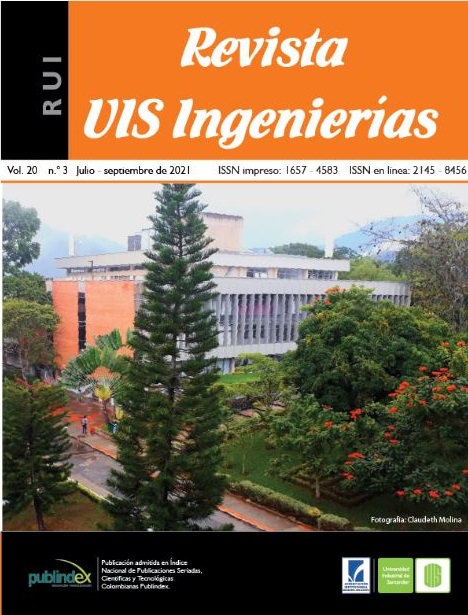Fare subsidy scheme to strengthen the operation in Colombia’s public transportation strategic systems
Published 2021-05-10
Keywords
- public transport,
- discrete choice models,
- fare subsidy
How to Cite
Abstract
This article proposes different actions to improve the future operation of the Strategic Public Transportation Systems (SETP) implemented in eight Colombian cities as part of the goals proposed in the National Urban Transportation Policy. More than ten years have passed since was formalized this implementation; however, SETP has not entered into operation yet. In contrast, there has been greater use of motorcycles and technological platforms that favored and made more efficient informal transport to detriment the road safety and air quality. In this research, using surveys of declared preferences established the perception of the SETP user's loyalty to informal transport. The situations analyzed consisted of answering which mode of transportation the participant would use under travel time, waiting time, and cost of the mode. In each case, several scenarios were presented that correlate the fare cost, the duration of the journey, and the waiting period. In addition, using the theory of random utility, it is possible to modify the increasing trend of informal transport if the quality of the public transport service is improved and a subsidy is established to the fare for a specific group of users. A binary model was estimated that included the choice between using informal transport and the subsidized SETP. Also, sociodemographic variables such as age and stratum were included, which allowed us to better explain the behavior of individuals, and it was possible to define the interval of the possible subsidy to reduce the fare. The results showed that subsidies are positively related to the increase in public transport users, but not so much as an improvement in travel times and the degree of coverage. This result shows that an adequate fare scheme policy is not only based on a reduction in the fare but must also include the improvement of the service provision.
Downloads
References
[2] Ley 1151, “Por la cual se expide el Plan Nacional de Desarrollo 2006-2010 Estado comunitario desarrollo para todos”, DNP, Bogotá, D.C., 2007.
[3] Gobierno Nacional-Decreto 3422, “Por el cual se reglamentan los Sistemas Estratégicos de Transporte Público (SETP) de conformidad con la Ley 1151 de 2007,” Ministerio de Transporte, Bogotá, D.C., 2009.
[4] Gobierno Nacional-Decreto 1079, “Por el cual se expide el Decreto Único Reglamentario para el Sector Transporte,” Ministerio de Transporte, Bogotá, D.C., 2015.
[5] DNP-CONPES 3833, “Seguimiento a los sistemas de transporte público (SITM-SETP). Ajuste del perfil de aportes y recomposición de componentes,” DNP, Bogotá, D.C., 2015.
[6] M. R. Porce, J. B. Gonzalez, y O. M. B. Real, Programa de Sistemas Estratégicos de Transporte Público (SETP) Caso de estudio Colombia. Bogotá, D.C. Colombia: BID-Banco Interamericano de Desarrollo, 2018.
[7] DNP-CONPES 3896, “Seguimiento de la Política Nacional de Transporte Urbano y Masivo: Lineamientos para la redistribución de componentes cofinanciables de los SETP.,” DNP, Bogotá, D.C., 2017.
[8] DANE, “Proyecciones de población”, 2019, [En línea]. Disponible: https://www.dane.gov.co/index.php/estadisticas-por-tema/demografia-y-poblacion/proyecciones-de-poblacion
[9] DANE, “Encuesta de transporte urbano de pasajeros (ETUP) Históricos”, 2019, [En línea]. Disponible: https://www.dane.gov.co/index.php/estadisticas-por-tema/transporte/encuesta-de-transporte-urbano-etup/transporte-urbano-automotor-de-pasajeros
[10] Ministerio de Transporte, “Anuario Estadístico Transporte en Cifras - Estadísticas 2018”, 03 Mayo 2019. [En línea]. Disponible: https://www.mintransporte.gov.co/documentos/15/estadisticas/
[11] Agencia nacional de Seguridad Vial, Boletín Estadístico Colombia: Fallecidos y Lesionados Serie Nacional Comparativo 2017-2018. Bogotá, D.C., Colombia: Observatorio Nacional de Seguridad Vial, 2019.
[12] Agencia Nacional de Seguridad Vial, “Observatorio Nacional de Seguridad Vial”, 10 Abril 2018. [En línea]. Disponible: https://ansv.maps.arcgis.com/apps/webappviewer/index.html?id=5a1bdb5c4fe041e0bb9892fd3748cf6a.
[13] J. Chica, H. Gachs-Sanchez y C. Lizarraga, “Route effect on the perception of public transport services quality”, Transport Policy, vol. 64, pp. 40-48, 2018, doi: 10.1016/j.tranpol.2017.03.024
[14] J. d. D. Ortuzar y L. Willumsen, Modelos de Transporte. Santander, España: Ediciones de la Universidad de Cantabria, 2008.
[15] Kocur, G.; Adler, T., Hyman, W. y Aunet, B., Guide to forecasting travel demand with direct utility assessment. Washington, D.C, USA: Urban Mass administration, US Department of Transportation, 1982.
[16] L. Basso y S. Jara-Díaz, “The case for subsidisation of urban public transport and the Mohring effect”, Journal of Transport Economics and Policy, vol. 44, no. 6, pp. 365-372, 2010.
[17] J. M. Arranza, M. Burguilloa y J. Rubio, “Subsidisation of public transport fares for the young: An impact evaluation analysis for the Madrid Metropolitan Area”, Transport Policy, vol.74, pp. 84-92, 2019, doi: 10.1016/j.tranpol.2018.11.008
[18] L. Márquez, R. Pico, V. Cantillo, “Understanding captive user behavior in the competition between BRT and motorcycle taxis”, Transport policy, vol. 61, pp. 1-9, 2018, doi: 10.1016/j.tranpol.2017.10.003
[19] KTrain, Discrete Choice Methods with Simulation. Cambridge, Inglaterra: University Press, 2003.
[20] L. Márquez, “Disposición a pagar por reducir el tiempo de viaje en Tunja (Colombia): Comparación entre estudiantes y trabajadores con un modelo Logit mixto”, Lecturas de Economía, vol. 1, no. 78, pp. 45-72, 2013.
[21] I. Makarova, A. Pashkevich, K. Shubenkova, “Ensuring sustainability of public transport system through rational management”, Procedia Engineering, vol. 178, pp. 137-146, 2017, doi: 10.1016/j.proeng.2017.01.078


